Family : Lutjanidae

Text © Giuseppe Mazza

English translation by Mario Beltramini
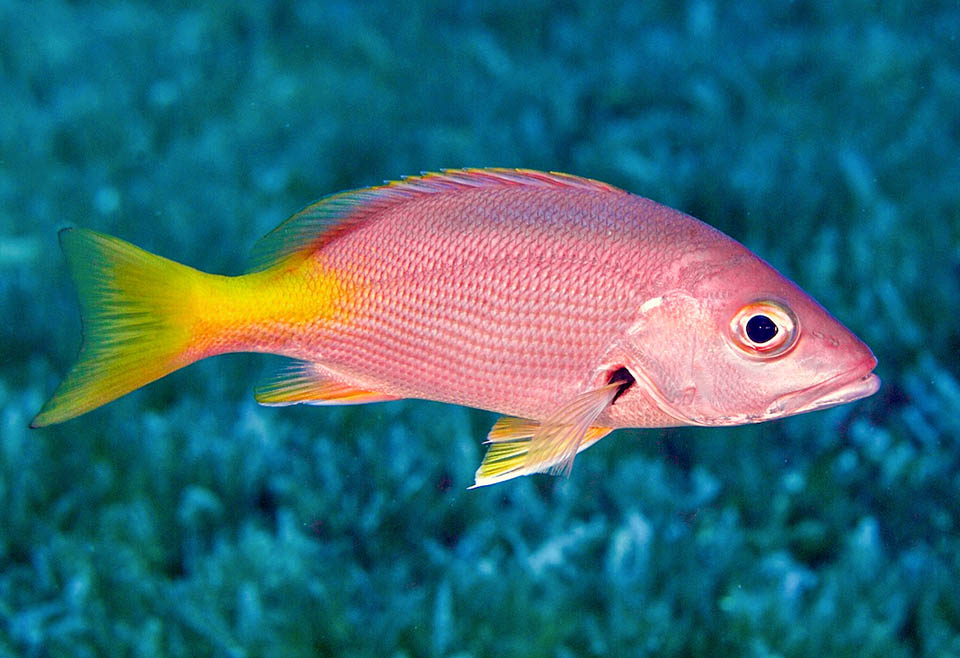
Even 75 cm long weighing 14 kg and a current size of 50 cm, Lutjanus buccanella is very common in the deep Caribbean coastal waters © Allison & Carlos Estape
The Blackfin snapper, Lutjanus buccanella (Cuvier, 1828), so called because of the characteristic black spot at the base of the pectoral fins, belongs, like all snappers, to the family of the Lutjanidae, the so-called snapping fishes due to their voracity comparable to that of the real dentexes, however assigned taxonomically to the family of the Sparidae.
Like these, it belongs to the class of the Actinopterygii, the ray-finned fishes, to the large order of the Perciformes, rich of more than 7000 species, and to the suborder of the Percoidei.
The genus Lutjanus, created by Bloch in 1790 for Lutjanus lutjanus, originates from the Indonesian fishermen gave to the described fish, whilst the specific term buccanella comes from “boucanella”, the vulgar name used in Martinique.
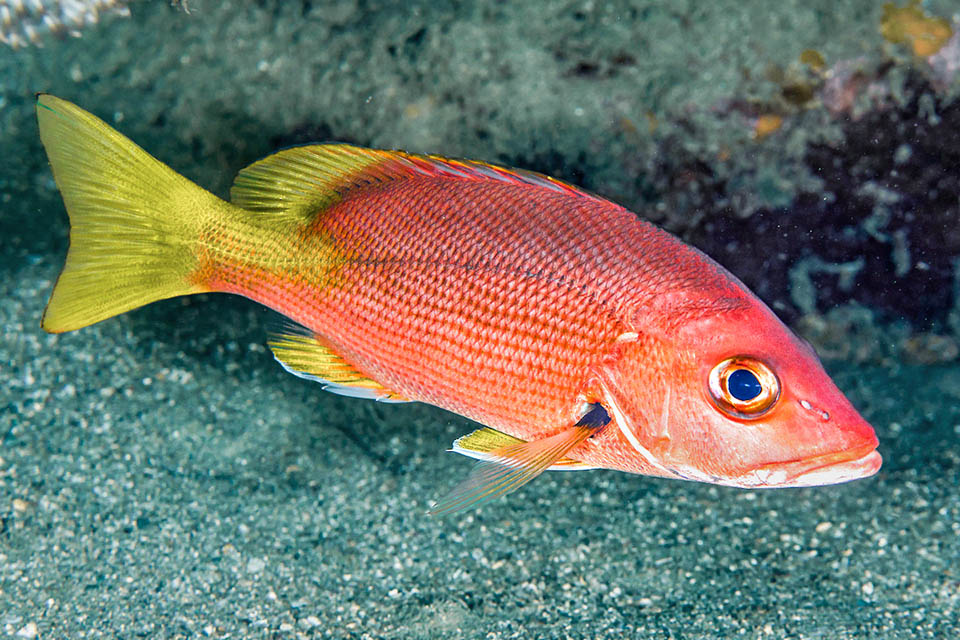
Though often scarlet, it owes its common name of Blackfin snapper to the tiny dark spot located at the base of the pectoral fins © Allison & Carlos Estape
Zoogeography
Quite common in the Antilles, Lutjanus buccanella is present, associated with the coral reefs, in the west Atlantic, from North Carolina and Bermudas, to the Gulf of Mexico, the Caribbean Sea, Trinidad and Tobago and the northern coasts of Brazil.
Ecology-Habitat
Even if the juveniles live mainly in relatively shallow waters, between 6 and 18 m, the Blackfin snapper is a deep water fish swimming offshore, even 1 km from the coast, close to the continental shelf between 60 and 90 m, going down close to cliffs and ledges up to 273 m of depth on sandy or rocky seabeds where it can be often found in small schools of 20-30 individuals.
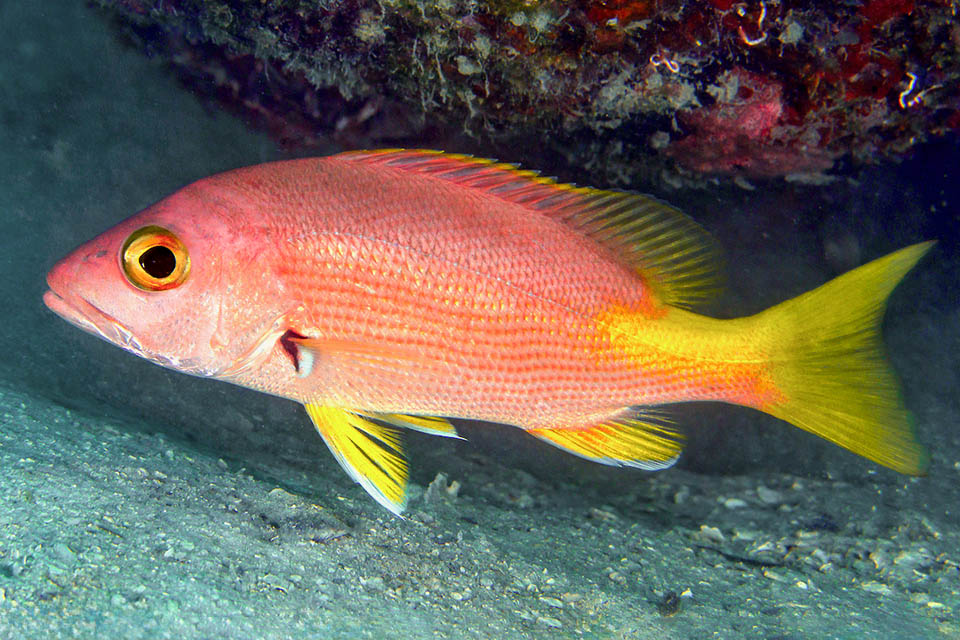
It chiefly eats fishes and crustaceans, but also cephalopods, sponges and ascidia and is much caught locally for its prized flesh, even if at times at ciguatera risk © Allison & Carlos Estape
Morphophysiology
Lutjanus buccanella may reach the length of 75 cm and a maximum published weight of 14 kg, though the current size is of around 50 cm.
The body is relatively high and compressed on the sides, with jaws without scales as well as the pointed snout that has two simple holes, on each side, for the front and back nostrils. The eye has yellow-orange iris, and above the lateral line the scales do not overlap horizontally like on the body but diagonally.
The upper jaw, slightly protractile, when closed slips under the cheekbone for a good part of its length.
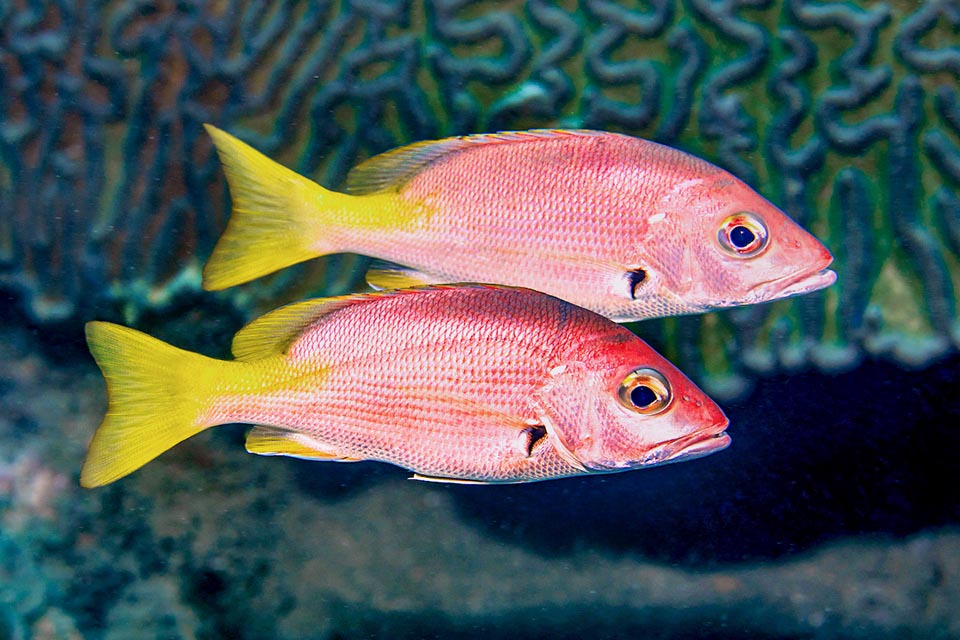
It reproduces practically all year round with a peak in April and another in September. The fecundated eggs, pelagic, are entrusted to the currents © Allison & Carlos Estape
The teeth, conical and pointed with some canines, are present also on the palate where they form, approached as in other Lutjanidae, a patch of spikes arranged in shape of an anchor with an elongated spindle. Finally, there is, at the top of the mouth, a patch of palatine teeth on each side.
The dorsal fin has 10 spiny rays and 14 soft; the anal 3 spiny rays and 8 unarmed. The pectoral ones, pointed and unarmed like the pelvic, count 14-18 r&ys. The caudal is slightly emarginate.
The adults have yellow fins, tending orange, and the body is mainly scarlet red with silvery reflections toward the belly. At the base of the soft part of the dorsal fin at times we note a darker zone. The juveniles resemble the adults but the yellow patch on the caudal peduncle is ampler and more conspicuous.
Ethology-Reproductive Biology
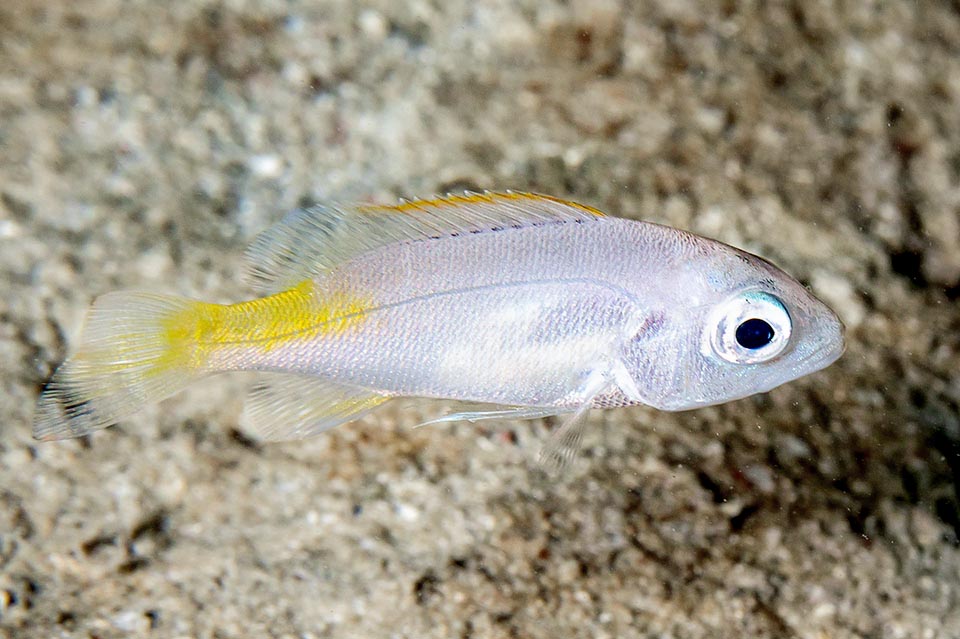
Juvenile shortly after larval phase. Stands out at once the characteristic yellow spot toward the caudal peduncle © Allison & Carlos Estape
Initially, Lutjanus buccanella nourishes of invertebrates, mostly shrimps and worms, passing then to the fishes that are the course of the adults, integrated with crustaceans, cephalopods, sponges and ascidia.
The Blackfin spanner reaches the sexual maturity during its second year of life when about 23-27 cm long, even if some Authors talk of 23-49,5 cm, hunted by sharks, barracudas, groupers, moray eels and especially by the man being its flesh excellent though, like all Caribbean predators, at risk of ciguatera, a severe food poisoning theoretically possible if they have preyed upon animals storing in their tissues the toxin produced by the dinoflagellate Gambierdiscus toxicus.
Lutjanus buccanella is caught for sport and professionally with lines, traps, longlines and nets. Throughout its distribution area it is a very important species for human nutrition, if we consider that only in Cuba, in 2008, 5 tons of it have been caught.
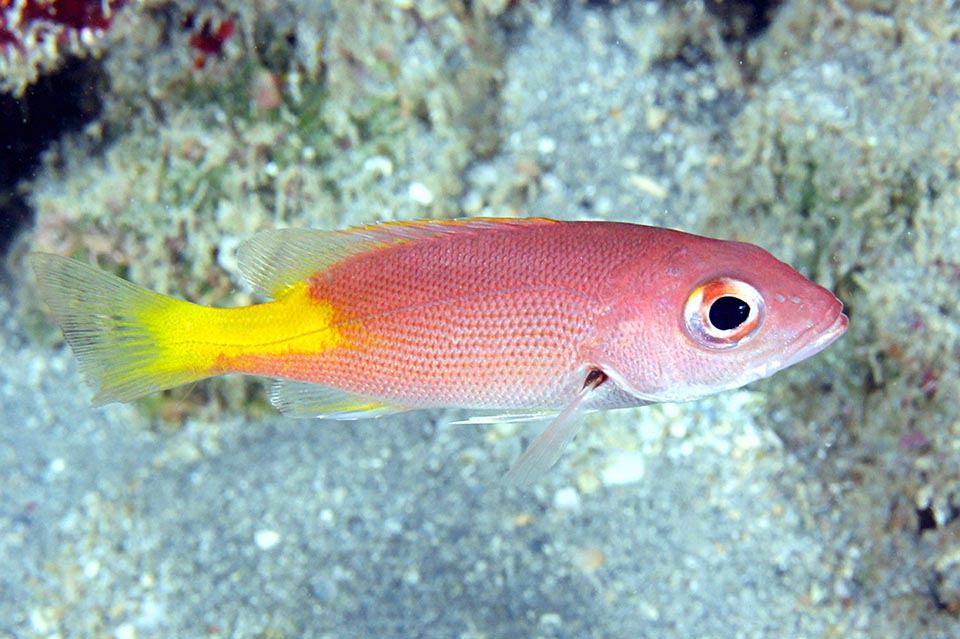
Later on they quickly get the adults’ look. Little is known about the trend of populations and the species consequently appears as “DD, Data Deficient” in the IUCN Red List © Kevin Bryant
It reproduces practically all year round with a peak in April and another one in September. Initially the juveniles are clear silvery with bluish shades, have a vast yellow zone starting from under the soft rays of the dorsal fin to reach finally the caudal peduncle.
The resilience of the species is mediocre, with a minimum time for the doubling of the populations of 1,4-4,4 years and the fishing vulnerability, decidedly high, marks already 62 on a scale of 100. We do not have precise data on the trend of the populations and the longevity of the species: some talk of 6 years, others of 20.
Lutjanus buccanella therefore appears from 2015 as “DD, Data deficient ” in the IUCN Red List of the endangered species.
Synonyms
Mesoprion buccanella Cuvier, 1828; Mesoprion caudanotatus Poey, 1851.
→ For general information about FISH please click here.
→ For general information about BONY FISH please click here
→ For general information about CARTILAGINOUS FISH please click here.
→ To appreciate the BIODIVERSITY of BONY FISH please click here.
→ To appreciate the BIODIVERSITY of CARTILAGINOUS FISH please click here.
